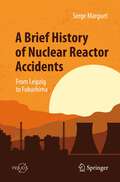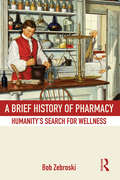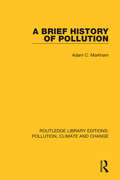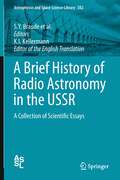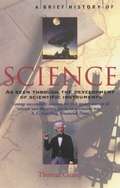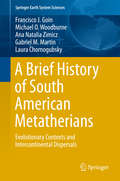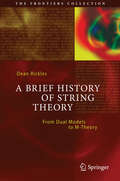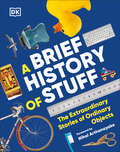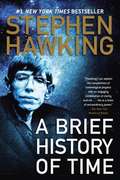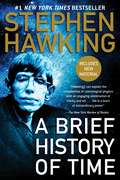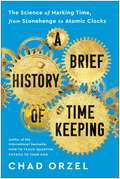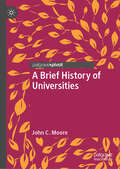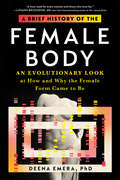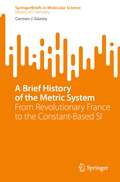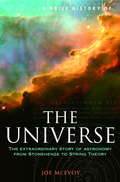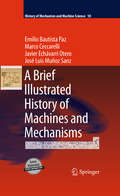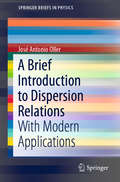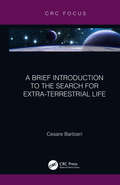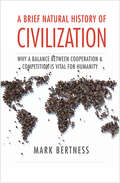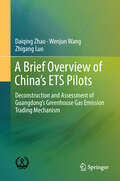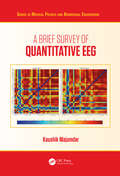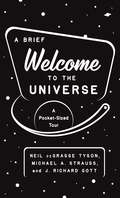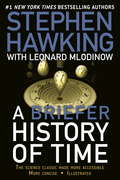- Table View
- List View
A Brief History of Mechanical Engineering (Materials Forming, Machining and Tribology)
by J. Paulo Davim Uday Shanker Dixit Manjuri HazarikaWhat is mechanical engineering? What a mechanical engineering does? How did the mechanical engineering change through ages? What is the future of mechanical engineering? This book answers these questions in a lucid manner. It also provides a brief chronological history of landmark events and answers questions such as: When was steam engine invented? Where was first CNC machine developed? When did the era of additive manufacturing start? When did the marriage of mechanical and electronics give birth to discipline of mechatronics? This book informs and create interest on mechanical engineering in the general public and particular in students. It also helps to sensitize the engineering fraternity about the historical aspects of engineering. At the same time, it provides a common sense knowledge of mechanical engineering in a handy manner.
A Brief History of Nuclear Reactor Accidents: From Leipzig to Fukushima (Springer Praxis Books)
by Serge MarguetAre you afraid of a nuclear reactor accident? Should you be? This book will arm you with the scientific knowledge necessary to make a rational and informed opinion on the subject, without having to be an expert in nuclear physics. Written so that a non-specialist can easily approach the highly technical aspects, it looks at all significant nuclear reactor accidents since the dawn of the Atomic Age and brings to light many crucial details that rarely, if ever, appear in the general media. Serge Marguet, an internationally renowned expert in reactor physics, breaks down the must-know technical aspects of numerous nuclear reactor accidents throughout history — both famous and unknown — from the first ever nuclear accident in Leipzig to the Chernobyl explosion and, finally, the Fukushima affair and its most recent developments. With many high-quality photographs and diagrams, this book is essential reading for anyone concerned about nuclear safety, curious about nuclear reactors, or simply interested in the history — and future — of nuclear power.
A Brief History of Pharmacy: Humanity's Search for Wellness
by Bob ZebroskiPharmacy has become an integral part of our lives. Nearly half of all 300 million Americans take at least one prescription drug daily, accounting for $250 billion per year in sales in the US alone. And this number doesn't even include the over-the-counter medications or health aids that are taken. How did this practice become such an essential part of our lives and our health? A Brief History of Pharmacy: Humanity's Search for Wellness aims to answer that question. As this short overview of the practice shows, the search for well-being through the ingestion or application of natural products and artificially derived compounds is as old as humanity itself. From the Mesopotamians to the corner drug store, Bob Zebroski describes how treatments were sought, highlights some of the main victories of each time period, and shows how we came to be people who rely on drugs to feel better, to live longer, and look younger. This accessible survey of pharmaceutical history is essential reading for all students of pharmacy.
A Brief History of Pollution
by Adam C. MarkhamOriginally published in 1994, this book links the distant past with the urgent problems of today, taking the reader on a literary and scientific tour of global pollution from pre-history to the post-industrial age. Ancient problems such as lead poisoning in Rome and water pollution in Mesopotamia provide the background to a discussion of modern catastrophes including the hole in the ozone layer, climate change and the global drinking water crisis. The book chronicles 800 years of pollution in London, charts the growth of environmental activism and spotlights the rise of the consumer society as the driving force behind today’s malaise.
A Brief History of Radio Astronomy in the USSR: A Collection of Scientific Essays (Astrophysics and Space Science Library #382)
by K. I. Kellermann Yu. N. Pariiskii N. L. Kaidanovskii O. N. Rzhiga I. S. Shklovskii V. A. Samanian N. S. Kardashev R. L. Sorochenko S. Y. Braude A. D. Kuzmin M. M. Kobrin V. S. Troitskii B. A. Dubinskii A. P. Molchanov A. E. SalomonovichThis translation of A Brief History of Radio Astronomy in the USSR makes descriptions of the antennas and instrumentation used in the USSR, the astronomical discoveries, as well as interesting personal backgrounds of many of the early key players in Soviet radio astronomy available in the English language for the first time. This book is a collection of memoirs recounting an interesting but largely still dark era of Soviet astronomy. The arrangement of the essays is determined primarily by the time when radio astronomy studies began at the institutions involved. These include the Lebedev Physical Institute (FIAN), Gorkii State University and the affiliated Physical-Technical Institute (GIFTI), Moscow State University Sternberg Astronomical institute (GAISH) and Space Research Institute (IKI), the Department of Radio Astronomy of the Main Astronomical Observatory in Pulkovo (GAO), Special Astrophysical Observatory (SAO), Byurakan Astrophysical Observatory (BAO), Crimean Astrophysical Observatory, Academy of Sciences of the Ukraine (SSR), Institute of Radio Physics and Electronics of the USSR Academy of Sciences (IRE), Institute of Terrestrial Magnetism, the Ionosphere and Radio-Wave Propagation Institute (IZMIRAN), Siberian Institute of Terrestrial Magnetism, the Ionosphere and Radio-Wave Propagation (SibIZMIRAN), the Radio Astrophysical Observatory of the Latvian Academy of Sciences and Leningrad State University. A Brief History of Radio Astronomy in the USSR is a fascinating source of information on a past era of scientific culture and fields of research including the Soviet SETI activities. Anyone interested in the recent history of science will enjoy reading this volume.
A Brief History of Science (Brief History of Ser.)
by Thomas CrumpAn exploration of scientific advances throughout time. From earliest pre-history, with the dawning understanding of fire and its many uses, up to the astonishing advances of the 21st century, Thomas Crump traces the increasingly sophisticated means employed in our attempts to understand the universe. The result is an account of how our curious nature has continually pushed forward the frontiers of science and, as a consequence, human civilization.
A Brief History of South American Metatherians: Evolutionary Contexts and Intercontinental Dispersals (Springer Earth System Sciences)
by Michael O. Woodburne Francisco J. Goin Ana Natalia Zimicz Gabriel M. Martin Laura ChornogubskyThis book summarizes major aspects of the evolution of South American metatherians, including their epistemologic, phylogenetic, biogeographic, faunal, tectonic, paleoclimatic, and metabolic contexts. A brief overview of the evolution of each major South American lineage ("Ameridelphia", Sparassodonta, Didelphimorphia, Paucituberculata, Microbiotheria, and Polydolopimorphia) is provided. It is argued that due to physiological constraints, metatherian evolution closely followed the conditions imposed by global temperatures. In general terms, during the Paleocene and the early Eocene multiple radiations of metatherian lineages occurred, with many adaptive types exploiting insectivorous, frugivorous, and omnivorous adaptive zones. In turn, a mixture of generalized and specialized types, the latter mainly exploiting carnivorous and granivorous-folivorous adaptive zones, characterized the second half of the Cenozoic. In both periods, climate was the critical driver of their radiation and turnovers.
A Brief History of String Theory: From Dual Models to M-Theory (The Frontiers Collection)
by Dean RicklesDuring its forty year lifespan, string theory has always had the power to divide, being called both a 'theory of everything' and a 'theory of nothing'. Critics have even questioned whether it qualifies as a scientific theory at all. This book adopts an objective stance, standing back from the question of the truth or falsity of string theory and instead focusing on how it came to be and how it came to occupy its present position in physics. An unexpectedly rich history is revealed, with deep connections to our most well-established physical theories. Fully self-contained and written in a lively fashion, the book will appeal to a wide variety of readers from novice to specialist.
A Brief History of Stuff: The Extraordinary Stories of Ordinary Objects
by DKLearn how 30,000 bath toys and the work of amateur beachcombers have helped scientists study ocean currents. Explore how the search for a death ray led to the creation of the microwave oven and ready-made meals. Discover the surprising link between sticky tape and the Nobel Prize. Uncover the extraordinary stories of ordinary objects in this perfect gift for curious minds. From the creators of the A Brief History of Stuff podcast and inspired by the incredible artifacts in the Science Museum Group Collection, this collection of entertaining essays reveals the fascinating history behind some of the most mundane items in our homes.
A Brief History of Time - Updated and Expanded 10th Anniversary Edition
by Stephen HawkingA Brief History of Time. This is the Famous book by Steven Hawking updated for the Tenth anniversary of its publication. Learn all you wanted to know about the universe and cosmology.
A Brief History of Time: From The Big Bang To Black Holes
by Stephen Hawking<P>A landmark volume in science writing by one of the great minds of our time, Stephen Hawking's book explores such profound questions as: How did the universe begin--and what made its start possible? Does time always flow forward? Is the universe unending--or are there boundaries? Are there other dimensions in space? What will happen when it all ends? <P>Told in language we all can understand, A Brief History of Time plunges into the exotic realms of black holes and quarks, of antimatter and "arrows of time," of the big bang and a bigger God--where the possibilities are wondrous and unexpected. With exciting images and profound imagination, Stephen Hawking brings us closer to the ultimate secrets at the very heart of creation of time and space. <P><b>A New York Times Bestseller</b>
A Brief History of Timekeeping: The Science of Marking Time, from Stonehenge to Atomic Clocks
by Chad Orzel2022 NATIONAL INDIE EXCELLENCE AWARDS WINNER — HISTORY: GENERAL ". . . inherently interesting, unique, and highly recommended addition to personal, professional, community, college, and academic library Physics of Time & Scientific Measurement history collections, and supplemental curriculum studies lists.&” —Midwest Book Review "A wonderful look into understanding and recording time, Orzel&’s latest is appropriate for all readers who are curious about those ticks and tocks that mark nearly every aspect of our lives." —Booklist &“A thorough, enjoyable exploration of the history and science behind measuring time.&” —Foreword Reviews It&’s all a matter of time—literally. From the movements of the spheres to the slipperiness of relativity, the story of science unfolds through the fascinating history of humanity&’s efforts to keep time. Our modern lives are ruled by clocks and watches, smartphone apps and calendar programs. While our gadgets may be new, however, the drive to measure and master time is anything but—and in A Brief History of Timekeeping, Chad Orzel traces the path from Stonehenge to your smartphone. Predating written language and marching on through human history, the desire for ever-better timekeeping has spurred technological innovation and sparked theories that radically reshaped our understanding of the universe and our place in it. Orzel, a physicist and the bestselling author of Breakfast with Einstein and How to Teach Quantum Physics to Your Dog continues his tradition of demystifying thorny scientific concepts by using the clocks and calendars central to our everyday activities as a jumping-off point to explore the science underlying the ways we keep track of our time. Ancient solstice markers (which still work perfectly 5,000 years later) depend on the basic astrophysics of our solar system; mechanical clocks owe their development to Newtonian physics; and the ultra-precise atomic timekeeping that enables GPS hinges on the predictable oddities of quantum mechanics. Along the way, Orzel visits the delicate negotiations involved in Gregorian calendar reform, the intricate and entirely unique system employed by the Maya, and how the problem of synchronizing clocks at different locations ultimately required us to abandon the idea of time as an absolute and universal quantity. Sharp and engaging, A Brief History of Timekeeping is a story not just about the science of sundials, sandglasses, and mechanical clocks, but also the politics of calendars and time zones, the philosophy of measurement, and the nature of space and time itself. For those interested in science, technology, or history, or anyone who&’s ever wondered about the instruments that divide our days into moments: the time you spend reading this book may fly, and it is certain to be well spent.
A Brief History of Universities
by John C. MooreIn this book, John C. Moore surveys the history of universities, from their origin in the Middle Ages to the present. Universities have survived the disruptive power of the Protestant Reformation, the Scientific, French, and Industrial Revolutions, and the turmoil of two world wars—and they have been exported to every continent through Western imperialism. Moore deftly tells this story in a series of chronological chapters, covering major developments such as the rise of literary humanism and the printing press, the “Berlin model” of universities as research institutions, the growing importance of science and technology, and the global wave of campus activism that rocked the twentieth century. Focusing on significant individuals and global contexts, he highlights how the university has absorbed influences without losing its central traditions. Today, Moore argues, as universities seek corporate solutions to twenty-first-century problems, we must renew our commitment to a higher education that produces not only technicians, but citizens.
A Brief History of the Female Body: An Evolutionary Look at How and Why the Female Form Came to Be
by Dr. Deena EmeraFrom breasts and orgasms to periods, pregnancies, and menopause—A Brief History of the Female Body is a fascinating science book explaining the mysteries of the female body through an evolutionary lens.Let's face it: The female body is an enigma. For teenagers first experiencing their periods, the monthly arrival of mood swings and cramps can be agonizing and inconvenient. With pregnancy—perhaps the most miraculous of bodily events—comes countless potential complications, including high blood pressure, diabetes, premature birth, and postpartum depression. And menopause is equally mystifying. Why do females lose their fertility over time and experience the notorious side effects—like hot flashes, weight gain, and hair loss—while males maintain their fertility forever?Evolutionary geneticist and educator Dr. Deena Emera has spent much of her career studying the evolution of female reproduction. A Brief History of the Female Body draws on her vast expertise as a biologist, her experience as a mother of four children, and her love of teaching to look far into our evolutionary past, illuminating how and, more importantly, why the female form has transformed over millions of years and its effects on women's health.
A Brief History of the Metric System: From Revolutionary France to the Constant-Based SI (SpringerBriefs in Molecular Science)
by Carmen J. GiuntaThis book succinctly traces the history of the metric system from early modern proposals of decimal measures, to the birth of the system in Revolutionary France, through its formal international adoption under the supervision of an international General Committee of Weights and Measures (CGPM), to its later expansion into the International System of Units (SI), currently formulated entirely in terms of physical constants. The wide range of human activities that employ weights and measures, from practical commerce to esoteric science, influenced both the development and the diffusion of the metric system. The roles of constants of nature in the formulation of the 18th-century metric system and in the 21st-century reformulation of the SI are described. Finally, the status of the system in the United States, the last major holdout against its everyday use, is also discussed.
A Brief History of the Universe: From Ancient Babylon To The Big Bang (Brief Histories )
by J. P. McEvoySince the dawn of humanity, men have attempted to divine the nature of the heavens. The first astronomers mapped the movement of the seasons and used the positions of the constellations for augurs and astrology. Today, the search goes ever deeper into the nature of reality and life itself. In this accessible overview, astrophysicist J.P. McEvoy tells the story of how our knowledge of the cosmos has developed. He puts in context many of the greatest discoveries of all time and many of the dominant personalities: Aristotle, Copernicus, and Isaac Newton, and as we approach the modern era, Einstein, Eddington, and Hawking.
A Brief History of the Universe: From Ancient Babylon to the Big Bang (Brief Histories)
by J.P. McEvoySince the dawn of humanity, men have attempted to divine the nature of the heavens. The first astronomers mapped the movement of the seasons and used the positions of the constellations for augurs and astrology. Today, the search goes ever deeper into the nature of reality and life itself. In this accessible overview, astrophysicist J.P. McEvoy tells the story of how our knowledge of the cosmos has developed. He puts in context many of the greatest discoveries of all time and many of the dominant personalities: Aristotle, Copernicus, and Isaac Newton, and as we approach the modern era, Einstein, Eddington, and Hawking.
A Brief Illustrated History of Machines and Mechanisms (History of Mechanism and Machine Science #10)
by Marco Ceccarelli Emilio Bautista Paz Javier Echávarri Otero José Luis Muñoz SanzThis work deals with mechanical manufacturing processes in history, examined through the machines associated with those processes. A tool is only included if it is part of a machine tool, with devices made up of moving parts. Once the analytical field has been marked out, the chosen descriptive method is basically graphic. This historical compendium attempts to give a wide-angle view of historical development without making an in-depth analysis of each of the examples presented. Moreover, this book illustrates the historical development of machines and mechanisms more from a technical point of view rather than a strictly history of science point of view since the authors are mechanical engineers who are interested and motivated to examine the most significant facts in their own area of knowledge of the Theory of Machines and Mechanisms. A full understanding of the historical development of Technology also needs the help of experts in technical matters who can appreciate and reassess bygone achievements in the light of their own technical knowledge. More collaboration between science historians and technical experts is needed, as is currently the case in the field of Industrial Archaeology. Thus, this book is also an attempt to set out a technical approach to the historical development of machines and mechanisms, but without too many technical details that will prevent its understanding being purely historical. At the beginning of each chapter there is a global reference to the period embraced, the most relevant facts, and the most significant treatises in the context of machine history. Following this introduction each chapter contains a series of sections on the types of machines that are representative of the period analysed together with illustrations to accompany the text. A fairly extensive bibliography enables the reader to make a deeper historical analysis.
A Brief Introduction to Dispersion Relations: With Modern Applications (SpringerBriefs in Physics)
by José Antonio OllerThis text offers a brief introduction to the dispersion relations as an approach to calculate S-matrix elements, a formalism that allows one to take advantage of the analytical structure of scattering amplitudes following the basic principles of unitarity and causality.First, the case of two-body scattering is considered and then its contribution to other processes through final-state interactions is discussed. For two-body scattering amplitudes, the general expression for a partial-wave amplitude is derived in the approximation where the crossed channel dynamics is neglected. This is taken as the starting point for many interesting nonperturbative applications, both in the light and heavy quark sector. Subsequently crossed channel dynamics is introduced within the equations for calculating the partial-wave amplitudes. Some applications based on methods that treat crossed-channel dynamics perturbatively are discussed too.The last part of this introductory treatment is dedicated to the further impact of scattering amplitudes on a variety of processes through final-state interactions. Several possible approaches are discussed such as the Muskhelishvili-Omnes dispersive integral equations and other closed formulae. These different formalisms are then applied in particular to the study of resonances presenting a number of challenging properties. The book ends with a chapter illustrating the use of dispersion relations in the nuclear medium for the evaluation of the energy density in nuclear matter.
A Brief Introduction to the Search for Extra-Terrestrial Life
by Cesare BarbieriThis book provides an introduction, from the astronomical point of view of the author, to the exciting search for extra-terrestrial life, and an overview of the current status of research into ‘alien’ life in the Solar System and beyond. It also explores the potential future human exploration of the Moon and Mars. Up-to-date with the latest developments in the field and accompanied by key references for further study, it is a fantastic introduction to the field of astrobiology for non-science majors taking an elective module, in addition to undergraduates studying physics with an interest in this area. Features: Contains the latest groundbreaking research in the hunt for life outside of Earth Discusses the identification of biosignatures in exo-planets Reviews future options for human outposts on the Moon and Mars
A Brief Natural History of Civilization: Why a Balance Between Cooperation and Competition Is Vital to Humanity
by Mark BertnessA compelling evolutionary narrative that reveals how human civilization follows the same ecological rules that shape all life on Earth Offering a bold new understanding of who we are, where we came from, and where we are going, noted ecologist Mark Bertness argues that human beings and their civilization are the products of the same self-organization, evolutionary adaptation, and natural selection processes that have created all other life on Earth. Bertness follows the evolutionary process from the primordial soup of two billion years ago through today, exploring the ways opposing forces of competition and cooperation have led to current assemblages of people, animals, and plants. Bertness’s thoughtful examination of human history from the perspective of natural history provides new insights about why and how civilization developed as it has and explores how humans, as a species, might have to consciously overrule our evolutionary drivers to survive future challenges.
A Brief Overview of China’s ETS Pilots: Deconstruction And Assessment Of Guangdong's Greenhouse Gas Emission Trading Mechanism
by Daiqing Zhao Wenjun Wang Zhigang LuoThis book systematically introduces readers to the framework of China’s ETS pilots, exploring their design and operating process, the current state of the carbon market, and various barriers encountered. To do so, it deconstructs the Guangdong ETS, which is the largest and most representative of China’s seven ETS pilots. The book subsequently describes and evaluates all seven pilots in terms of their efficiency, macro and micro effects, the method involved in the DEA model, the CGE model, and cost-benefit analysis. In turn, in the assessment section it demonstrates how some ETS pilots have failed to control carbon emissions due to inordinately high emissions quotas issued by the local government etc. Further, it argues that ETS should focus on those industries with large emissions and high mitigating potential for the time being, and then gradually expand the scale of its coverage.As China’s national ETS is slated for launch on the basis of the lessons learned from the ETS pilots, the book offers a timely and valuable resource for all those who want to understand and forecast the development of China’s ETS. It includes a wealth of descriptions and explanations of Chinese government policies involving carbon emissions control, making it a unique resource.
A Brief Survey of Quantitative EEG (Series in Medical Physics and Biomedical Engineering)
by Kaushik MajumdarThis book presents a holistic approach to quantitative EEG from its neurological basis to simultaneous EEG and fMRI studies. Equal emphasis is given to major mathematical and statistical theories and computational techniques and their applications on clinical and laboratory experimental EEG.
A Brief Welcome to the Universe: A Pocket-Sized Tour
by J. Richard Gott Michael A. Strauss Neil deGrasse TysonA pocket-style edition based on the New York Times bestsellerA Brief Welcome to the Universe offers a breathtaking tour of the cosmos, from planets, stars, and galaxies to black holes and time loops. Bestselling authors and acclaimed astrophysicists Neil deGrasse Tyson, Michael A. Strauss, and J. Richard Gott take readers on an unforgettable journey of exploration to reveal how our universe actually works.Propelling you from our home solar system to the outermost frontiers of space, this book builds your cosmic insight and perspective through a marvelously entertaining narrative. How do stars live and die? What are the prospects of intelligent life elsewhere in the universe? How did the universe begin? Why is it expanding and accelerating? Is our universe alone or part of an infinite multiverse? Exploring these and many other questions, this pocket-friendly book is your passport into the wonders of our evolving cosmos.
A Briefer History of Time: The Science Classic Made More Accessible
by Stephen Hawking Leonard MlodinowFROM ONE OF THE MOST BRILLIANT MINDS OF OUR TIME COMES A BOOK THAT CLARIFIES HIS MOST IMPORTANT IDEAS Stephen Hawking's worldwide bestseller A Brief History of Time remains a landmark volume in scientific writing. But for readers who have asked for a more accessible formulation of its key concepts--the nature of space and time, the role of God in creation, and the history and future of the universe--A Briefer History of Time is Professor Hawking's response. Although "briefer," this book is much more than a mere explanation of Hawking's earlier work. A Briefer History of Time both clarifies and expands on the great subjects of the original, and records the latest developments in the field--from string theory to the search for a unified theory of all the forces of physics. Thirty-seven full-color illustrations enhance the text and make A Briefer History of Time an exhilarating and must-have addition in its own right to the great literature of science and ideas.From the Hardcover edition.ersed throughout the book have now been given entire chapters of their own, including relativity, curved space, and quantum theory. This reorganization has allowed the authors to expand areas of special interest and recent progress, from the latest developments in string theory to exciting developments in the search for a complete unified theory of all the forces of physics. Like prior editions of the book--but even more so--A Briefer History of Time will guide nonscientists everywhere in the ongoing search for the tantalizing secrets at the heart of time and space.From the Hardcover edition.

